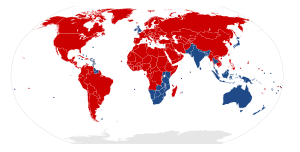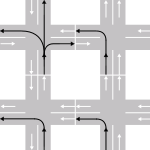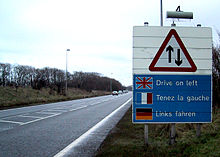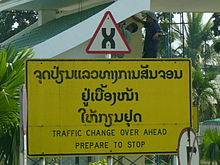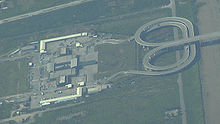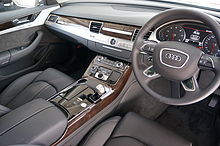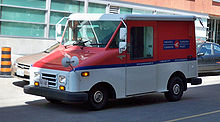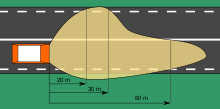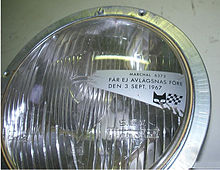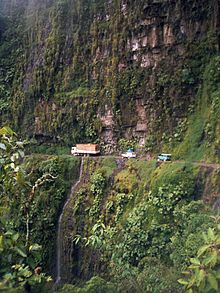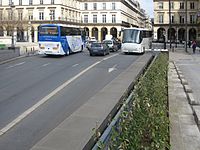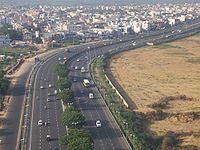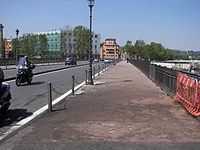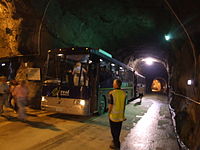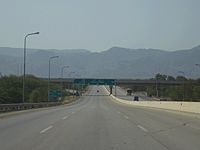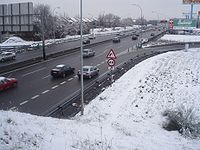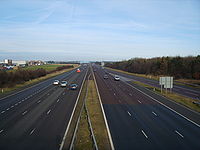
Right- and left-hand traffic
Background Information
SOS Children, which runs nearly 200 sos schools in the developing world, organised this selection. A quick link for child sponsorship is http://www.sponsor-a-child.org.uk/
The terms right-hand traffic and left-hand traffic refer to regulations requiring all bidirectional traffic to keep either to the right or the left side of the road, respectively. This is so fundamental to traffic flow that it is sometimes referred to as the rule of the road. This basic rule eases traffic flow and reduces the risk of head-on collisions. Today, about 66.1% of the world's people live in right-hand traffic countries and 33.9% in left-hand traffic countries. About 72% of the world's total road distance carries traffic on the right, and 28% on the left.
Terminology
Universally (following a treaty; see below), each country specifies a uniform road traffic flow: left-hand traffic (LHT) in which traffic keeps to the left side of the road, or right-hand traffic (RHT) in which traffic keeps to the right.
Vehicles are usually manufactured in left-hand drive (LHD) and right-hand drive (RHD) configurations, referring to the placement of the driving seat and controls within the vehicle. Typically, the placement of the steering wheel is opposite to the rule of the road: LHT countries use RHD vehicles, and RHT countries use LHD vehicles. This is so that the driver's line of sight is as long as possible down the road past leading vehicles, an important consideration for overtaking (passing) manœuvres.
There are LHT countries where most vehicles are LHD (see Caribbean islands below)—and there are some countries with RHT and mostly RHD vehicles, such as Afghanistan, Burma, and the Russian Far East, in the last case due to import of used vehicles from Japan. Many countries permit both types of vehicles on their roads. Terminological confusion can arise from the misuse of left-hand drive or right-hand drive to indicate the side of the road along which vehicles are driven.
The terms nearside and offside are related terms used in some English-speaking countries to refer to the sides of a vehicle: the nearside is closest to the kerb and the offside is closest to the centre of the road.
Road traffic
Uniformity
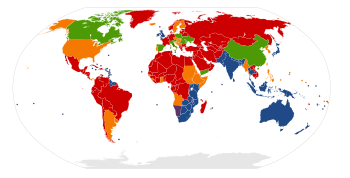
Signatory countries to the Geneva Convention on Road Traffic (1949) have agreed to a uniform direction of traffic in each country. Article 9(1) provides that
| “ | All vehicular traffic proceeding in the same direction on any road shall keep to the same side of the road, which shall be uniform in each country for all roads. Domestic regulations concerning one-way traffic shall not be affected. | ” |
In the past, several countries had different rules in different parts of the country (e.g., Canada until the 1920s). Currently, China, the United States and the United Kingdom each have territories which differ from their primary traffic rule. In China the bulk of the country drives on the right, but the special administrative regions of Hong Kong and Macau – which were transferred to the country in the late 1990s – drive on the left. In the United States the country drives on the right side of the road, but traffic in the US Virgin Islands – like on many Caribbean islands – drives on the left side of the road. The United Kingdom drives on the left, but the overseas territory of Gibraltar drives on the right. In the cases of the US and UK, it is not possible to drive between right-hand and left-hand regions; however, Hong Kong and Macau (both left-hand) border the remainder of China (right-hand).
Right-hand traffic
- All traffic is generally required to keep right unless overtaking.
- Oncoming traffic is seen coming from the left.
- Left-turning traffic must cross oncoming traffic.
- Most traffic signs facing motorists are on the right side of the road.
- Traffic on roundabouts (traffic circles or rotaries) goes counterclockwise.
- Pedestrians crossing a two-way road look first for traffic from their left.
- The lane designated for normal driving and turning right is on the right.
- Most dual carriageway (divided highway) exits are on the right
- Other vehicles are generally overtaken (passed) on the left, though in some circumstances overtaking on the right is permitted.
- Most vehicles have the driving seat on the left.
- A right turn at a red light may be allowed after stopping.
- On roads without a footpath pedestrians may be advised to walk on the left.
Left-hand traffic
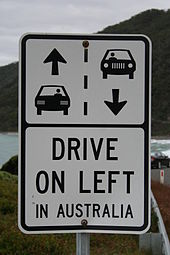
- All traffic is generally required to keep left unless overtaking.
- Oncoming traffic is seen coming from the right.
- Right-turning traffic must cross oncoming traffic.
- Most traffic signs facing motorists are on the left side of the road.
- Traffic on roundabouts (traffic circles or rotaries) goes clockwise.
- Pedestrians crossing a two-way road look first for traffic from their right.
- The lane designated for normal driving and turning left is on the left.
- Most dual carriageway (divided highway) exits are on the left.
- Other vehicles are overtaken (passed) on the right, though in some circumstances overtaking on the left is permitted.
- Most vehicles have the driving seat on the right.
- A left turn at a red light may be allowed after stopping.
- On roads without a footpath pedestrians may be advised to walk on the right.
Jurisdictions with right-hand traffic
Note: Italics indicates year of change to driving on the right.
*1758 in Copenhagen, 1793 in the rest of Denmark
**In South Yemen
Total: 164 countries and territories
Jurisdictions with left-hand traffic
Note: Italics indicates year of change to driving on the left.
* Until the late 1960s, imported vehicles from the USA were fitted with left-hand drive layout
Total: 76 countries, territories and dependencies
Today road traffic in the following seven European jurisdictions drives on the left: the United Kingdom, Ireland, Isle of Man, Guernsey, Jersey, Malta and Cyprus. None shares a land border with a country that drives on the right and all were once part of the British Empire. Some Commonwealth countries and other former British colonies, such as Australia, Bahamas, Brunei, Barbados, Hong Kong, Jamaica, Singapore, New Zealand, India, Bangladesh, Pakistan, Sri Lanka, Malaysia, South Africa and Trinidad & Tobago drive on the left, but others such as Canada, Gambia, Ghana, Nigeria, Sierra Leone and the United States drive on the right. Other countries that drive on the left in Asia are Thailand, Indonesia, Bhutan, Nepal, East Timor and Japan. In South America, only Guyana and Suriname drive on the left. Most of the Pacific countries drive on the left, in line with Australia and New Zealand, with Samoa joining most recently, on 7 September 2009, the first country for three decades to change the side on which it drives.
Changing sides at borders
Countries in Africa, Asia and South America have land borders where drivers must change to the other side of the road.
Where neighbouring countries drive on opposite sides of the road, drivers from one to the other must change sides when crossing the border. Thailand is particularly notable in this context. Thailand drives on the left; since Burma changed in 1970 from left to right, 90% of the Thailand border is with countries that drive on the right (only Malaysia drives on the left.) Other notable borders where a changeover is necessary are between Afghanistan and Pakistan, China and Pakistan, Iran and Pakistan, Mainland China and Hong Kong, and between South Sudan and Uganda.
When borders coincide with natural barriers, such as mountains (which may be in remote areas) or rivers, the traffic volumes are relatively low and the number of border crossings is reduced. This is true of many borders where traffic changes sides of the road, especially in Asia.
The four most common ways of switching traffic from one side to the other at borders are
- Traffic lights. Examples include
- Friendship Bridge between Thailand and Laos, on Lao side – 17.88739°N 102.71158°E
- Second Thai–Lao Friendship Bridge, between Thailand and Laos, on Thai side - photo – 16.60123°N 104.73016°E
- Mae Sot Friendship Bridge between Thailand and Burma – photo 16.69038°N 98.51663°E
- 2006 bridge between Thailand and Burma near Mae Sai – 20.4469°N 99.9031°E
- Crossover bridges. Examples include
- Lok Ma Chau between Hong Kong and mainland China – 22.51823°N 114.07080°E
- Lotus Bridge between Macau and mainland China – 22.14009°N 113.54970°E
- Hong Kong-Shenzhen Western Corridor between Hong Kong and mainland China – 22.489264°N 113.945943°E
- Takutu River Bridge between Guyana and Brazil – photo photo – 3.38127°N 59.80977°W
- Intersecting roads with roundabouts or other one-way traffic systems. Examples include
- Man Kam To between Hong Kong and mainland China – 22.53969°N 114.12734°E
- Portas do Cerco between Macau and mainland China – 22.21806°N 113.54927°E
- Signposts and directions only, most commonly found at borders with low traffic volumes. Examples include
- Poipet between Thailand and Cambodia
- Mae Sai old bridge between Thailand and Burma
- Khunjerab Pass between Pakistan-administered Kashmir and China
- Moyale between Kenya and Ethiopia
- Friendship Bridge between Nepal and China
- Nathu La pass between India and China
- Service tunnel of the Channel Tunnel between the United Kingdom and France (underground and not open to the public) – 50.92310°N 1.78093°E
Safety factors
Research in 1969 by J. J. Leeming showed countries driving on the left have a lower collision rate than countries driving on the right, although he acknowledged that the sample of left-hand rule countries he had to work with was small, and he was very careful not to claim that his results proved that the differences were due to the rule of the road. It has been suggested that this is partly because humans are more commonly right-eye dominant than left-eye dominant. In left-hand traffic, the predominantly better-performing right eye is used to monitor oncoming traffic and the driver's wing mirror (side mirror). In right-hand traffic, oncoming traffic and the driver's wing mirror are handled by the predominantly weaker left eye. In addition, it has been argued that left-sided driving is safer for elderly people given the likelihood of their having visual attention deficits on the left side and the need at intersections to watch out for vehicles approaching on the nearside lane. Furthermore, in an RHD car with manual transmission, the driver has the right hand, which for most people is dominant, on the steering wheel at all times and uses the left hand (and left foot) to change gears and operate most other controls.
Cyclists, motorcyclists and horse riders typically mount from the lefthand side. This places them on the kerb when driving on the left.
The largest safety issue is the coexistence of the two systems; visitors accustomed to one system might not act or react properly when visiting a region where the other system is used. For example, a pedestrian might look the wrong way before crossing a street.
Road racing
In road racing, most tracks are run in a clockwise direction, including those in countries with right-hand traffic, which have counterclockwise roundabouts. Since more corners are therefore to the right instead of left, using a right-hand drive car has an advantage both in the driver's view of a corner's apex, and also in the overall weight distribution, which would be toward the inside.
Trams (streetcars)
Tram and streetcar systems generally follow the same rules as normal road traffic in the country concerned, both on road and on reserved sections, with the passenger doors on the kerbside. Various exceptions exist or have existed, examples including the now-removed system in London where some sections of tramway had both tracks on the same side of the road with no physical separation from road traffic.
The driver is usually positioned near the centre of the vehicle, although some single-operator trams have been developed wherein the driver sits nearer the centre of the road. On the left-hand running Blackpool system and Melbourne trams built between the 1970s and 1990s, the driver sits on the right. Before the extensive system was dismantled, Sydney trams also drove on the left-hand side.
When Sweden changed to driving on the right, its single-ended trams had the doors on the wrong side, and this was taken as an excuse to close down several systems. Gothenburg operated its trams in opposite-handed pairs, the left-hand-drive tram leading before the changeover and the right-hand-drive tram afterwards. Over time, all trams have been converted with many trams built in the sixties still being operated. In the northeastern part of the system, the trams pass through a tunnel under Hammarkullen, which lies on top of a steep hill. Since building a single central platform was cheaper, the trams switch sides at Hjällbo and run on the left past the last four stops.
In Vienna, around the underground stations Donauspital and Kagran, Tramlines 25 and 26 change to the left to prevent passengers from crossing the tram tracks.
The Belgian Charleroi Metro has a stretch of left-side operation at the outer end of its underground line to Gilly. The stations at this end have central platforms and the switch of sides has been introduced so that passengers can alight on the right side of the vehicle at all stations.
Vehicles
Driver seating position
On most early motor vehicles, the driving seat was positioned centrally. Some car manufacturers later chose to place it on the side of the car closer to the kerb to help the driver avoid scraping walls, hedges, gutters and other obstacles. Other car manufacturers placed the driving seat on the side closer to the centre of the road to give the driver the longest possible line of sight in traffic. This is the pattern that eventually prevailed. Today experimental versions of drive by wire and brake by wire vehicles are being developed which allow the driver to slide the steering wheel/brake controls from left to right with the gauges in the centre dashboard. They are expected to become popular in countries such as Thailand that have land borders with opposite-drive countries. The newest Unimog models can be changed from left-hand drive to right-hand drive in the field to permit operators to work on the more convenient side of the truck.
History
In 1998, archaeologists found a well-preserved track leading to a Roman quarry near Swindon, England. The grooves in the road on the left side (viewed facing down the track away from the quarry) were much deeper than those on the right side. These grooves suggest that the Romans drove on the left, at least in this particular location, since carts would exit the quarry heavily loaded, and enter it empty.
Some historians, such as C. Northcote Parkinson, believed that ancient travellers on horseback generally rode on the left side of the road. As more people are right-handed, a horseman would thus be able to hold the reins with his left hand and keep his right hand free—to offer in friendship to passing riders or to defend himself with a sword, if necessary.
The history of the keep-left rule could be tracked back to ancient Greece, Egypt and Rome. In retrospect, it was more widely practised than right-side traffic. Ancient Greeks, Egyptians and Romans adhered to the left side while marching their troops. If two men riding on horseback were to start a fight, each would edge toward the left. Thus, they would be enabled to draw swords from their right and uphold a defensive position. Eventually, this turned into custom, and later, a law. The keep-left rule was doubtless well-established in ancient Rome. Resulting from congestions in the city, strict traffic rules came into being. In the city of Rome rules banned wagons and chariots during the day; in other parts of the Empire wheeled traffic was banned during the night – so as not to disturb citizens from sleep. Thousands of pilgrims arrived to Rome forming one massive celebration of the eternal church. Pilgrims who wished to visit the city were instructed to keep to the left side of the road. By the time the Pope ordered instructions to keep left of the road, this rule was already widely used. The regulation has been practised by some countries ever since.
There is a popular story that Napoleon changed the rule of the road in the European countries he conquered from keep-left to keep-right. Some justifications are symbolic, such as that Napoleon himself was left- (or right-) handed, or that Britain, Napoleon's enemy, kept left. Alternatively, troops passing on the left may have been tempted to raise their right fists against each other. Forcing them to pass on the right reduced conflict. Hence, island nations such as Britain and Japan (using ships to move troops around and having less need to move them overland) continued to drive on the left. These stories have never been shown to have a factual basis and appear to be apocryphal.
In the late 18th century, the shift from left to right that took place in countries such as the United States was based on teamsters’ use of large freight wagons pulled by several pairs of horses. The wagons had no driver's seat, so a postilion sat on the left rear horse and held his whip in his right hand. Seated on the left, the driver preferred that other wagons pass him on the left so that he could be sure to keep clear of the wheels of oncoming wagons. He did that by driving on the right side of the road.
Changing to right-hand traffic
In Russia, in 1709, Danish envoy under Peter I noted the widespread custom for traffic in Russia to pass on the right. On 5 February 1752, Empress Elizabeth issued an edict for traffic to keep to the right in Russian cities. In England, on the other hand, keeping to the left was the custom. The first legal reference in Britain to an order for traffic to keep to the left was in 1756 with regard to London Bridge. The General Highways Act of 1773 contained a recommendation that horse traffic should keep to the left and this was incorporated in the Highway Act 1835. The making of a rule was due to the increase in horse traffic by the end of the 18th century. By 1771, the number of coaches rose from 300 in 1639 to 1000. Countries that became part of the British Empire adopted the British keep-left rule, although some have since changed.
In Continental Europe, driving on the right is associated with France and Napoleon. During the French Revolution of 1789, a decree issued in Paris ordered traffic to move to the "common" right. A little later, Napoleon Bonaparte consolidate this position by ordering the military to stay on the right side, even when out of the country, so that everyone who met the French army, had to concede the way. In the early 19th century, those countries occupied by or allied to Napoleon - the Netherlands, Switzerland, Germany, Italy, Poland, Spain - adopted right-hand traffic. Britain, Austria-Hungary and Portugal continued or adopted left-hand traffic. In Denmark, the keep-right rule was adopted in Copenhagen in 1758, and the rule was adopted for the rest of Denmark in 1793. In Belgium, before 1899 there was no uniform system, with some places driving on the left and others on the right. On 1 August 1899, Belgium changed to right-hand traffic throughout the country. There was a movement in the 20th century towards harmonisation of laws in Europe and there has been a gradual shift from driving on the left to the right. Portugal changed to right-hand traffic in 1928, though the change did not apply to its colonies. Those parts of Italy not already driving on the right changed over in the 1920s after Benito Mussolini came to power. In Spain, there was no uniform national rule until the 1930s. Before then, some parts had driving on the right (e.g., Barcelona) while in others it was on the left (e.g., Madrid). On 1 October 1924, Madrid changed to driving on the right. The Austro-Hungarian Empire drove on the left. Successor countries switched to the right separately. Austria did it in stages, beginning from the west: Vorarlberg in 1919, Tirol and western half of Salzburg in 1930, Carinthia and East Tirol in 1935, Upper Austria, Styria, eastern half of Salzburg in 1 June 1938, and Lower Austria in 19 September 1938. Poland's Galicia switched to the right around 1924. Czechoslovakia planned to start driving on the right on 1 May 1939, but the change in Bohemia and Moravia was prompted by the German occupation forces (Bohemia: 17 March 1939, Prague: 26 March, see switch to right hand traffic in Czechoslovakia for details). Hungary also acted later than planned: the government decided for a change in June 1939, but postponed it and finally introduced it on 6 July 1941 (outside Budapest), and on 9 November 1941 in Budapest. Sweden changed in 1967 and Iceland did the same in 1968. (For the logistics involved, see the Swedish experience at Dagen H.) In Europe only four countries still drive on the left: the United Kingdom, Ireland, Malta and Cyprus, as well as the British territories of Isle of Man, Guernsey and Jersey.
In the Americas, all the formerly British, Spanish and Portuguese colonies in the Americas originally kept to the left. The first keep-right law in the United States was passed in 1792 and applied to the Philadelphia and Lancaster Turnpike. New York changed to right-hand traffic in 1804 and New Jersey in 1813. By the time the United States annexed French, Spanish, Russian and Hawaiian territories, the keep-right rule already applied there. Today, all U.S. states and territories except the U.S. Virgin Islands drive on the right. The Virgin Islands drove on the left when the United States purchased the former Danish West Indies from Denmark in 1917. Although Denmark drove and still drives on the right, the Danish West Indies drove on the left because, some say, the majority of the European aristocracy living there were British; but there is also a claim the practice of left-side drive was due to the first cars being RHD vehicles imported from Barbados, then still a British colony.
Those parts of Canada that were still driving on the left changed over by 1924. Ontario and Québec drove on the right since before their takeover from the French, and were allowed to retain the custom. The central provinces also drove on the right. The eastern and western provinces changed to the right in stages: British Columbia on 1 January 1922, New Brunswick on 1 December 1922, Nova Scotia on 15 April 1923, and Prince Edward Island on 1 May 1924. Newfoundland changed to driving on the left in 1947 before becoming part of Canada in 1949. Brazil changed to right-hand traffic in 1928. Before then, Brazil had nonuniform rules. During the planning of the Pan American Highway from Alaska to Cape Horn in the 1930s, it was decided that the road should use right-hand driving on its entire length. Panama changed in 1943 and Argentina, Paraguay and Uruguay did the same in 1945. British Honduras (now Belize) changed to right-hand traffic in 1961. Guyana and Suriname as well as most English-speaking Caribbean countries are the only countries in the Americas that drive on the left. Both Guyana and Suriname are separated from their neighbours by large rivers, with the first bridge crossing one of these only opening in April 2009.
The Philippines changed in 1945 and China changed in 1946. Taiwan drove on the left under Japanese rule, but changed to driving on the right in 1946 after the government of the Republic of China assumed administration; the same happened in North and South Korea, another former Japanese colony. Burma changed in 1970, allegedly on the advice of a wizard.
In Africa, the colonial masters usually determined on which side of the road traffic would drive. The British and Portuguese territories kept to the left, while French and German territories kept to the right. After independence some countries kept the previous rules, while others changed. The most common reason for countries to switch to right-hand traffic is to harmonize with neighbors, to improve road safety and commerce. Several former British colonies changed to driving on the right, because they all have extensive borders with former French colonies, which drive on the right: the Gambia (changed on 1 October 1965), Sierra Leone (1 March 1971), Nigeria (2 April 1972) and Ghana (4 August 1974). Ethiopia changed to right-hand traffic in 1964, and Sudan changed in August 1973 to accord with most other countries of the Arab world. South Yemen, formerly the British colony of Aden, changed to driving on the right on 1 January 1977; North Yemen already drove on the right. The former Portuguese colony of Mozambique continues to drive on the left, which is a legacy of its Portuguese past, even though Portugal itself changed over in the 1920s. However, Mozambique continues to drive on the left because all its bordering countries, which were in the British Empire, do so. Namibia was a German colony from 1884 until the First World War, and kept to the right. After its occupation by South Africa in 1918, it changed to the left. When it obtained independence in 1990, it maintained left-hand drive as its neighbors South Africa and Botswana. Rwanda, a former Belgian colony in central Africa, currently drives on the right. The government is presently considering changing to driving on the left, to bring the country in line with other members of the East African Community (EAC). Burundi is the only other EAC member to drive on the right.
Decisions by countries to drive on the right typically centre on regional uniformity. There are historical exceptions, such as postilion riders in France, but such historical advantages do not apply to modern road vehicles.
Changing to left-hand traffic
The Japanese prefecture of Okinawa, under US military occupation and driving on the right since 24 June 1945, switched back to the left-hand traffic used by the rest of Japan on 30 July 1978. The event is locally known as " 730".
Samoa changed to left-hand traffic in September 2009. The government brought about the change to bring Samoa into line with other South Pacific nations, and also sought to encourage the roughly 170,000 Samoan expatriates in Australia and New Zealand to ship their used cars back to Samoa. Under Indonesian rule, East Timor changed from right to left-hand traffic in 1976 and retained the directional change after becoming independent in 2002.
Foreign occupation and annexation
Many countries have temporarily or permanently changed their rule of the road as a result of foreign occupation or annexation. Examples include Austria (at the Anschluss) and Czechoslovakia ( details) under German rule or military transit in the 1930s and 1940s. In the Faroe Islands left-hand driving was in force on the roads of the island of Vágar during the British occupation in the Second World War. The Channel Islands changed to driving on the right under German occupation, but changed back after liberation in 1945. The Falkland Islands did the same under Argentine control during the 1982 Falklands War, although many islanders continued to drive on the left as an act of defiance. East Timor changed to driving on the left under Indonesian rule in 1976, and continues the practice as an independent state.
The Japanese region of Okinawa changed from left to right under US control; in 1972 Okinawa was returned to Japanese sovereignty, and six years later, in 1978, the driving rules reverted to left-hand traffic as in mainland Japan.
Korea (which was part of Japan from 1910-1945) also changed from left to right at the end of World War II. This occurred in September 1945, when Soviet-backed forces occupied the North and American forces arrived in the southern half of Korea. Shortly afterwards the peninsula was divided along the 38th parallel. Driving on the right was implemented in both territories because military vehicles were now either American-made or Russian-built LHD models.
Legal restrictions on wrong-hand drive vehicles
For reasons of safety, politics, or economic market protection, some countries ban the sale or import of vehicles with the steering wheel on the wrong side.
In Kenya, it is illegal to register LHD vehicles, a rule set by the Kenya Bureau of Standards. Exceptions are made for special vehicles such as ambulances, fire engines, construction vehicles or vehicles to be donated to the government.
In Australia, registration of non-vintage (i.e., less than 30 years old) LHD vehicles is illegal. Imported LHD vehicles less than 30 years old (15 years old in Western Australia) must be converted to RHD (potentially costing thousands of dollars), or driven with a permit that imposes severe usage restrictions. However, Western Australia and the Northern Territory (both that have at various times hosted US military facilities and had vehicles imported, used and sold by US service personnel) have LHD vehicles in circulation. The Australian Capital Territory (ACT) previously allowed non-vintage LHD vehicles to be registered, but changed its legislation some years ago. However, in the Northern Territory, LHD vehicle registration is allowed if the vehicle was used for at least 12 months whilst overseas by a migrant or Australian citizen returning home.
In India, LHD vehicles cannot be sold commercially to customers, but they can be imported for research and testing purposes under government approval.
In New Zealand, LHD vehicles may be privately imported, and driven locally under an LHD permit. Since 1999, only LHD vehicles older than 20 years or cars owned and operated for at least 90 days may be privately imported. Diplomats and Operation Deep Freeze personnel are exempted from these restrictions.
In the Philippines, RHD vehicles are banned. Previously, such vehicles were allowed, provided a "CAUTION: RIGHT HAND DRIVE" sign was prominently posted. Public buses and vans imported from Japan are converted to LHD, and passenger doors are created on the right side. This ban was thought to be the result of an increase in accidents involving RHD vehicles, most of which were trucks. However, some passenger vans keep their doors on the left side, leading to the dangerous situation in which passengers have to exit toward oncoming traffic. Some existing RHD industrial cranes and other off-road vehicles remain.
Cambodia banned the use of RHD cars, many of which were smuggled from Thailand, from 2001, even though RHD vehicles accounted for 80 percent of vehicles in the country. The government threatened to confiscate all such vehicles unless they were converted to LHD, in spite of the considerable expense involved. According to a BBC report, changing the steering column from right to left would cost between US$600 and US$2,000, in a country where the average annual income was less than US$1,000.
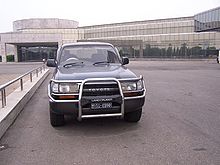
Although it drives on the right, North Korea has imported various used RHD vehicles from Japan, from tourist buses to Toyota Land Cruisers.
However, many used vehicles exported from Japan to countries like Russia and Peru are already converted to LHD. But even if the driver's position is left unchanged, some jurisdictions require at least replacement of the headlamps.
Singapore bans LHD vehicles from being imported for personal local registration, but temporary usage by tourists of LHD vehicles is allowed. However, diplomatic vehicles in Singapore are exempt from the RHD-only ruling, and there are a few hydrogen and fuel cell powered LHD vehicles currently undergoing trials in Singapore.
In Taiwan, Article 39 of the Road Traffic Security Rules requires a steering wheel to be on the left side of a vehicle to pass an inspection when registering the vehicle, so RHD vehicles may not be registered in Taiwan. This rule does not apply retroactively, so an RHD vehicle that was registered before this rule does not lose its registered status and may continue to be legally driven.
In Trinidad and Tobago, LHD vehicles are banned except for returning nationals who were resident in a foreign country and are importing a vehicle for personal use. LHD vehicles are also allowed to be imported for use as funeral hearses.
In Paraguay, a RHD vehicle cannot be registered, except for fire engines.
In West Africa, once-British Ghana and the Gambia have also banned RHD vehicles. Their traffic has been changed from on the left to on the right. Ghana prohibited new registrations of RHD vehicles after 1 August 1974, three days before the traffic change on 4 August 1974. RHD vehicles may be imported only temporarily into Sierra Leone, for example for humanitarian programmes, but must be exported at the end of the operation.
Most of the above bans on RHD and LHD vehicles apply only to locally registered vehicles. Countries that have signed the 1968 Vienna Convention on Road Traffic are not allowed to make such restrictions on foreign-registered vehicles. Paragraph 1 of Annex 5 states "All vehicles in international traffic must meet the technical requirements in force in their country of registration when they first entered into service". Therefore all signatory countries and most non-signatory countries allow the temporary import (e.g., by tourists) of foreign-registered vehicles, no matter which side the steering wheel is on. Oman and Azerbaijan, which have not signed the Vienna Convention, ban all foreign-registered RHD vehicles.
Both RHD and LHD vehicles may generally be registered in any European Union member state, but there are some restrictions and regulations. Slovakia and Poland, despite being members of the European Union, do not allow the local registration of RHD vehicles, even if the vehicle is imported from one of the four EU countries that drive on the left (UK, Ireland, Cyprus, and Malta). Lithuania and Ukraine have prohibited new RHD vehicle registration since 1993.
Buses
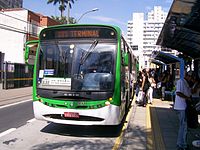
Buses typically have passenger doors only on the kerbside, which severely restricts their ability to operate effectively on the opposite side of the road to that for which they were designed. Increasingly, touring coaches, which are likely to cross frontiers of traffic-handedness during their duties, are fitted with a supplementary door on the opposite side from the kerb, to simplify access and egress in the foreign country. In Britain this is known as a "continental door", since its usefulness will be in continental Europe. It doubles as an emergency exit, but is much more user-friendly than an exit designed solely for emergency use. This is also found in some Hong Kong-China cross-border coaches.
It is usually fairly straightforward to retrofit a non-kerbside door on buses with relatively low floor height; the many traditional British double-deckers sold on for tourist use in the USA and Canada are examples.
There are buses with doors on both sides, which allow operation at bus stops in the middle of avenues, such as in some Brazilian cities.
Some BRT systems operate with buses that have doors only (or mainly) on the opposite side from the kerb, intended to operate in stations or bus stops in the centre of an avenue with dedicated lanes, such as TransMilenio (LHD) in Bogotá, Colombia and Rea Vaya (RHD), in Johannesburg, South Africa, the last only for articulated buses operating in trunk lines.
Trucks
In northern Italy trucks were often RHD so that the driver could see the edge of the road on Alpine passes. In Spain trucks were RHD until the 1950s, to enable drivers to watch for unstable road edges.
Postal and other service vehicles
Post Office cars and vans in some countries such as the United States, Canada, Finland and Sweden have the steering wheel on the opposite side to normal vehicles. This is so drivers can easily drive up next to post boxes or get out straight onto the pavement without having to walk around their vehicles, or put post in boxes without getting out of their vehicles at all.
In the US, rural mail carriers often must provide their own vehicles and have a limited selection of RHD vehicles that they can choose to buy or lease. Some utility service vehicles are also RHD to allow dismounting at the kerb and some newspaper carriers use RHD vehicles to deliver papers to kerbside boxes rather than drive along routes on the wrong side. The Jeep Wrangler is available in the United States in RHD configuration, since this particular model is popular with rural mail carriers who sometimes operate in less-than-optimal road conditions and thus appreciate the Wrangler's 4WD capabilities. Between 1991 and 1999, Subaru manufactured and sold a right-hand steering version of its all-wheel-drive Legacy station wagon model for use by US mail rural route and highway contract route box delivery carriers, and many of the vehicles remain in use, with the dwindling supply of used right-hand steering Subarus much sought after by mail and newspaper carriers. Saturn made a SWP (Station Wagon Postal) starting in 1996, using the same RHD steering gear used when the S-series started being exported to Japan.
In Europe, RHD vehicles are bought by the postal services and are offered by several manufacturers, since such vehicles are produced for the British market. Likewise, LHD vehicles are possible to buy for use in Britain. With EU rules, used vehicles can be sold over the border, making it easier to sell used vehicles. Before that it was very hard to sell vehicles steered from the "wrong" side.
In Australia and the UK, LHD street sweeper trucks are common for the purpose of the drivers having a better view of the kerb they are cleaning. Street sweepers in North America are often RHD for the same reason. Some styles of Wheelie bin collection trucks also have kerb-side driver's seats to permit a better view of the bin as it is emptied. Some of these vehicles have dual-control systems, with a steering wheel and pedals on both sides of the cab, allowing the driver to operate from whichever side offers the best safety and visibility at the specific time.
Headlamps and other lighting equipment
Most low-beam headlamps produce an asymmetrical beam distribution suitable for use on only one side of the road. Low beam headlamps for use in LH-traffic countries throw most of their light forward-leftward; those for RH-traffic countries throw most of their light forward-rightward, thus illuminating obstacles and road signs an adequate distance ahead on the driver's own side of the road while limiting glare to oncoming traffic on the other side of the road.
Within Europe, headlamps designed and approved for use on one side of the road must be adaptable to produce adequate illumination with controlled glare for temporarily driving on the other side of the road, as for example on holiday or in transit. This adaptation may be achieved by affixing masking strips or prismatic lenses to a designated part of the lens or by moving all or part of the headlamp optic so all or part of the beam is shifted or the asymmetrical portion is occluded. Some varieties of the projector-type headlamp can be fully adjusted to produce a proper LH- or RH-traffic beam by shifting a lever or other movable element in or on the lamp assembly. Some vehicles adjust the headlamps automatically when the car's GPS detects that the vehicle has moved from LH to RH traffic or vice versa.
Because blackout strips and adhesive prismatic lenses reduce the safety performance of the headlamps, most countries require all vehicles registered or used on a permanent or semi-permanent basis within the country to be equipped with headlamps designed for the correct traffic-handedness.
Without sidecars attached, motorcycles, motor scooters, mopeds, and bicycles are almost symmetric with their handlebars in the centre. However, motorcycles are often equipped with automotive-type asymmetrical-beam headlamps that likewise require adjustments or replacement when brought into a country with opposite traffic-handedness.
Rear fog lamps
Within the European Union, each vehicle must be equipped with one or two red rear fog lamps. A single rear fog lamp may be located on the vehicle centreline, or on the driver's side of the vehicle. It may not be located on the passenger's side of the vehicle, where it may be replaced with a single reverse lamp. When importing a vehicle to a country which drives on the opposite side of the road, this sometimes requires the purchase and installation of local-market lighting components.
Specific jurisdictions
This section gives details about the road traffic, including trams and other light rail systems which include street running. Trains which use segregated tracks usually have separate rules and are included in the Trains section.
Afghanistan
Right hand traffic was introduced in Afghanistan by Ghulam Mohammad Farhad, the Mayor of Kabul, in the early 1950s, first in Kabul and later in the rest of the country. Today most vehicles in much of the country, however, are RHD cars imported from neighbouring Pakistan (with the exception of Herat and other western provinces). In the capital Kabul, most drivers have adapted to this problem, leaning over the passenger seat (on the car's left side) before making a left turn or before overtaking other vehicles by veering into the left (oncoming traffic) lane. The country also has a large volume of military vehicle traffic from the US, Canada and EU militaries, much of which is LHD.
Argentina
When the Pan American Highway from Alaska to Cape Horn was planned in the 1930s, it was decided it should use one side of driving its entire length. A few countries along the route used left-hand traffic, one being Argentina. On 10 October 1944 Decreto Nacional 26965 was issued, introducing right-hand traffic in Argentina eight months later, on 10 June 1945. Strict speed limits kept the number of fatal accidents low after the conversion. 10 June is still observed each year as Día de la Seguridad Vial (Road Safety Day) in Argentina.
Trains built by the British, as well as the Subte or underground railway in Buenos Aires, run on the left.
Australia
Australia drives on the left. The decision to drive on the left side of the road was made in the early 19th century in the early period of the British colony of New South Wales by Governor Lachlan Macquarie after the first road was built, and followed the British practice. Australian states and territories had used the "give way to the right" rule; in the absence of regulations specific to a particular situation, drivers must yield the right of way to all vehicles to their right. This applies to most uncontrolled intersections except for T-intersections. Give way to the right does not apply to merging lanes, in that instance vehicles must give way to any vehicle that is ahead. This is sometimes called zip merging. If lines are marked, vehicles are not zip merging but changing lanes, and they must give way accordingly. All LHD vehicles must be converted to RHD if under 30 years old, except in Western Australia where they are only required to be 15 years old for registration.
Austria-Hungary
The Austro-Hungarian Empire drove on the left. Successor countries switched to the right separately. Austria did it in stages, beginning from the west:
- Vorarlberg: 1919,
- Tirol and western half of Salzburg: 1930,
- Carinthia and East Tirol: 1935,
- Upper Austria, Styria, eastern half of Salzburg: 1 June 1938,
- Lower Austria: 19 September 1938.
The last sections of the Austrian Railways were switched to right-hand traffic as recently as 6 August 2012.
Poland's Galicia had switched to the right around 1924. Czechoslovakia planned to start driving on the right on 1 May 1939, but the change in Bohemia and Moravia was prompted by the German occupation forces (Bohemia: 17 March 1939, Prague: 26 March, see switch to right hand traffic in Czechoslovakia for details). Hungary also acted later than planned: the government decided about the change in June 1939, but postponed it and finally introduced it at 3am on 6 July 1941 (outside Budapest), and at 3am on 9 November 1941 in Budapest.
Bahamas
As a former British colony, the Bahamas has left-hand traffic. Most vehicles are imported from the United States and are thus left-hand-drive vehicles, however right-hand-drive vehicles also share the road.
Bangladesh
Being a former British colony, Bangladesh has left-hand traffic. Regulations require all imported vehicles to be right-hand drive—except those imported by foreign embassies or consulates—hence the popularity of used vehicles from Japan.
Belgium
Before 1899, there was no uniform system in Belgium. In some cities or provinces traffic drove on the left and in others on the right. Beginning on 1 August 1899, right-hand traffic was introduced in the whole country. Trains in Belgium still drive on the left.
Belize
As a former British colony, Belize (known until 1973 as British Honduras) drove on the left until 1961, when it changed to the right in anticipation of the Pan-American Highway being built to pass through the country. However, after Hurricane Hattie the government had to divert funds earmarked for the construction of the highway to disaster relief, so the highway does not in fact run through Belize.
Bosnia and Herzegovina
Bosnia and Herzegovina was part of the Austro Hungarian Empire at the beginning of the 20th century, and after the collapse of the empire, it started driving on the right.
Bolivia
Bolivia has right-hand traffic, with the exception of the notorious El Camino de la Muerte ("The Road of Death")—or simply known as Yungas Road, where it drives on left. The reason for this configuration is to help drivers see their outer wheel while traversing the road.
Brazil
Brazil changed to right-hand traffic in 1928. Before then, Brazil had nonuniform rules. Now, Brazil has only small segments of traffic driving on the left, only to accommodate special cases. Brazil funded construction of Takutu River Bridge, from Bonfim to Lethem, Guyana, the only remaining land border in Americas where traffic change sides. Brazil does not permits Guyana vehicles (RHD) to drive beyond the Brazilian border town of Bonfim. Brazilian vehicles (LHD) are able to drive all the way to the coast of Guyana.
Burma (Myanmar)
As a former British colony, cars in Burma drove on the left until 1970; the military administration of Ne Win decreed that traffic would drive on the right hand side of the road beginning 7 December 1970. It is alleged that this was because Ne Win had been advised by his astrologer, who had said "move to the right". In spite of the change, most passenger vehicles in the country continue to be RHD, being pre-changeover vehicles and second-hand vehicles imported from Japan, Thailand, and Singapore. Buses imported from Japan that were never converted from RHD to LHD, have doors on the right side in offset position, unlike their counterparts in the Philippines. However, government limousines, imported from the People's Republic of China, are LHD. Virtually all vehicles are driven with a passenger called a "spare" (စပယ်ရာ) in place to watch the oncoming traffic and inform the driver as to whether it is safe to overtake or not, as the driver cannot see this from the RHD position.
Cambodia
Cambodia follows a keep-to-the-right rule derived from France. In 2001 RHD cars, usually second hand from Thailand, were banned.
Canada
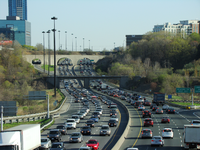
Canada drives on the right in LHD (left-hand-drive) vehicles, the largest land-area nation in the former British Commonwealth to do so. Until the 1920s, the rule of the road in Canada varied by province: British Columbia, New Brunswick, Nova Scotia, and Prince Edward Island had left-hand traffic, and the other provinces and territories had right-hand traffic. Starting on the west coast on 15 July 1920 and ending on the east coast on 1 May 1924, right-hand traffic was adopted uniformly throughout Canada. Newfoundland was not part of Canada until 1949, and had left-hand traffic until 2 January 1947.
Hundreds of thousands of right-hand drive (RHD) vehicles were built in Canada during World War II for the military from 1940 to 1945. Most of these were DND Pattern (later called Canadian Military Pattern) as well as some of the MCP (Modified Conventional Pattern i.e. civilian pattern) vehicles. The reason is that Canada's military forces were at that time intended to fight alongside the British military who used RHD vehicles. Britain also lost most of her military vehicles in France in the 1940 retreat and so she ordered thousands of new vehicles from Canada. Canadian Military Pattern (CMP) vehicles became the most standardised vehicles in the British Commonwealth. They were supplied to Canada, the UK, Australia, New Zealand, South Africa and India. Others were supplied to the USSR after they entered the war. A few, diverted from shipment to Canadian troops in Hong Kong, were supplied to the US Army in the Philippines and were used there until the Japanese captured the islands. Post-war, thousands of RHD Canadian-made vehicles were supplied to the United Nations for relief (UNRRA) of countries that had suffered greatly in World War II and went to countries such as Czechoslovakia and Greece. During the Cold War in the 1950s, Canada gave many more to allies such as Norway, the Netherlands, France and Italy. During the War, Canada had built RHD armoured vehicles such as tanks, armoured cars, armoured trucks, scout cars, universal carriers, tracked jeeps, etc.
A section of Autoroute 20 in Montreal has the two directional roadways "switched", so that the forward roadway is to the left. However, this is a freeway, so driving on the proper side is not a concern.
Caribbean
Most English-speaking Caribbean countries - such as Barbados, Jamaica, and Trinidad & Tobago - drive on the left and most cars have a RHD configuration.
However in some islands, mostly Lesser Antilles (such as the British Virgin Islands, US Virgin Islands, the Cayman Islands, as well as Turks and Caicos Islands) and the Bahamas, most passenger cars are still LHD-equipped (despite driving on the left), being imported from the United States or Brazil. Only some government cars and those imported from RHD countries (Japan and the United Kingdom, among others) are RHD. The US Virgin Islands are particularly known for having a high accident rate caused by American tourists from the mainland who are unfamiliar with driving on the left in their LHD rental cars.
The French Antilles (Guadeloupe, Martinique, Saint-Martin) and the Dutch Caribbean (Aruba, the Caribbean Netherlands, Curaçao, and Sint Maarten) drive on the right, with LHD car configurations.
China
In the late 19th century during the late Qing Dynasty, cars in the northern provinces like Shandong and Zhili (now Hebei) drove on the right due to American influence, and cars in the southern provinces and cities such as Guangdong, Shanghai, and Zhejiang drove on the left due to British influence, but left-hand traffic was uniform throughout the Republic of China in 1930s. As early as 1943, Clause 7 of Article 58 of the Act Governing the Punishment of Police Offences (Chinese: 違警罰法) required vehicular drivers in the Republic of China to keep left, subject to a fine of up to 20 yuan or a warning upon a violation. On 15 August 1945, the Nationalist Government ordered to change to right-hand traffic on 1 October 1945. However, on 26 September 1945, the Nationalist Government ordered to postpone changing to right-hand traffic on 1 January 1946. As China became a right-hand traffic country, Clause 7 of Article 58 of the Act Governing the Punishment of Police Offences was accordingly amended to require right-hand traffic in June 1946. The sovereignty over Hong Kong and Macau were transferred to the People's Republic of China in 1997 and 1999 respectively. However, both continue to drive on the left, and road border controls between China and Hong Kong and between China and Macau remain in place.
Croatia
Croatia was part of the Austro Hungarian Empire before the First World War, and after the collapse of the empire, it started driving on the right.
Among the rare exceptions to this is the entrance to the multi-storey car park of Importanne Gallery, at the Drago Ibler Square in Zagreb, which is located of the left side of a one-way street so the lanes on the entrance are reversed to provide for unrestricted flow of traffic between the car park and the street.
Cyprus
A former British colony, Cyprus drives on the left, and cars sold locally are right hand drive, including those used by the British forces in the Sovereign Base Areas of Akrotiri and Dhekelia. However, there is a sizable number of left-hand drive vehicles in northern Cyprus, which are imported from Turkey after it came under its occupation in 1974. As Cyprus is now an EU member since 2004, it is common to find left-hand drive vehicles also (tourists overland or else second hand imports from other EU countries with LHD vehicles), although a ban on imports of LHD vehicles has since been introduced under its jurisdiction. An increasing number of right hand drive grey import vehicles from Japan and the UK are now sold throughout the island.
Egypt
Road vehicles in Egypt use right hand traffic due to French cultural influence, during the era of Mohamed Ali in the early 19th century when the traffic system was planned. An exception is a section of one main street in Alexandria city centre called The Tram Road, where cars drive on the left for a few kilometres. The railway system was established in Egypt in the late 19th century by British companies during the British Colonial Era, and so trains travel on the left.
Ethiopia and Eritrea
Ethiopia changed from left-hand to right-hand traffic on 8 June 1964. Eritrea was at that time part of Ethiopia, so the same date is applicable for that country. The reason for the change is not clearly understood, as neighbouring Kenya in the south and Sudan in the west were driving on the left.
France
France has long been a right-hand traffic country.
However, along the 350 metres (1,148 feet) of Avenue du Général Lemonnier in Paris, which connects the Pont Royal to the Rue de Rivoli, traffic drives on the left, separated only by a hump. The N205 from Annecy up to Chamonix has a 5 km section between Le Fayet and Le Châtelard where the down carriageway has been built into the mountain side throwing the up carriageway onto high cantilevered sections, giving the unnerving experience of driving not just high in the air but on the left for several minutes before the carriageways recross and revert to the French norm.
Despite the rule of the road, trains are still typically driven on the left track, as long as they use their autonomous ways and there is usually no risk of confusion, and also because cars are forbidden to drive on the same lanes (traffic is physically separated). However, some local services tracks (notably those around harbours) which have very low traffic, are built on ways that are most often used by cars or open to cycles and pedestrians. In these cases, these special tracks may be driven by trains (only short carriers) in the same direction as the car traffic, at very low speed and with limitations of charge to avoid accidents. The Paris and Marseille metro systems, along with VAL metro systems in Lille, Toulouse, and Rennes, and the national railways in the formerly German regions of Alsace and Lorraine are operated on the right track. In Paris, though, the RER -Réseau Express Régional- RER is operated on the left track.
Gambia
The Gambia was the first of the former British colonies in west Africa to adopt right-hand traffic. The Gambia's only neighbour is the former French colony of Senegal. The Gambia implemented the switch-over 1 October 1965, months after its independence.
Ghana
Ghana changed to driving on the right-hand side on 4 August 1974; several stamps were issued to commemorate the switchover.
Gibraltar
Although the British overseas territory of Gibraltar changed to driving on the right on 16 June 1929 to avoid accidents involving vehicles from Spain, some public buses until recently were RHD, with a special door allowing passengers to enter on the right hand side. However, most passenger cars are LHD, as in Spain, with the exception of second-hand cars brought in from the UK and Japan as well as UK registered military vehicles used by the British Forces.
Guyana and Suriname
Guyana and Suriname are the only two remaining countries in the mainland Americas that drive on the left. As a result of the construction of the Pan-American Highway, four mainland American countries switched to driving on the right between 1943 and 1961, the last of which was British Honduras (now Belize). Both Guyana and Suriname are separated from their neighbours by large rivers, with the first bridge crossing one of these only opening in April 2009. The inland south of both countries is sparsely populated with very few roads and hence no border crossings.
In the south-west of Guyana, near Lethem, work was finally completed on 26 April 2009 on the Takutu River Bridge across the Takutu River into neighbouring Brazil, which drives on the right. The changeover system is on the Guyana side, with one lane passing under the other on the bridge's access road. Construction proceeded slowly over the years before being completed by the Brazilian army. Brazil had been keen to open the bridge, as it now gives Brazil access to Caribbean sea ports on the north coast of South America. Brazil intends to permit Guyana registered (RHD) vehicles to go no further than the Brazilian border town of Bonfim. It is expected that Brazilian (LHD) vehicles will be able to drive all the way through Guyana to the coast. The Takutu Bridge is the Americas' only border crossing where traffic changes sides of the road. Guyana however does allow used LHD vehicles to be imported from the United States and Canada allowing both LHD and RHD vehicles to be registered and permitted on its roads.
In Suriname most of the privately owned buses are imported from Japan, and the exits are designed for driving on the left. Most state-owned buses, however, are from the US (LHD) and often the placement of the exits has to be adjusted.
Hong Kong

As a former British colony, Hong Kong follows the United Kingdom in driving on the left.
Under the auspices of the one country, two systems arrangement, the practice of driving on the left continues in Hong Kong and Macau as a Special Administrative Regions of the People's Republic of China. Most vehicles, even those of the People's Liberation Army Hong Kong Garrison, are RHD. LHD exceptions include some buses providing services to and from the mainland.
There are four road border crossing points between mainland China and Hong Kong. The largest and busiest is Lok Ma Chau Control Point, which features two separate changeover systems on the mainland side. In 2006, the daily average number of vehicle trips recorded at Lok Ma Chau was 31,100. The next largest is Man Kam To, where there is no changeover system and the border roads on the mainland side simply intersect as one-way streets with a main road.
There are some exceptions. Public Square Street in Yau Ma Tei used to have a small stretch between New Reclamation Street and Shanghai Street with right-hand traffic. Drake Street in Admiralty has an eastbound bus lane on its southern side, leading to a bus terminal. In Tsim Sha Tsui East, Hong Wing Path to the west of one-way northbound Hong Chong Road carries only southbound traffic. The two streets are immediately next to each other, separated only by concrete barriers. In addition, many carparks have their entrances and exits inverted if they are located on one-way roads or roads with separation barriers.
Iceland
Iceland switched traffic from left to right at 06:00 on Sunday 26 May 1968, known as H-dagurinn. As in Sweden, most passenger cars were already left hand drive. The only injury attributed to the changeover was to a boy on a bicycle, who broke his leg. Numerous buses were also stuck in traffic jams.
India
Following British colonial influence, India drives on the left hand side of the road. Now all vehicles are RHD with the government banning all new LHD vehicles in the country except under special circumstances, such as cars imported duty free by foreign embassies. All left hand drive vehicles (including new ones manufactured for export) carry a prominent sticker reading 'Left Hand Drive Vehicle' on their back to warn other drivers.
There are some legal exceptions to this rule, to overcome traffic problems, where traffic moves on the right hand side of the road. In Bangalore, for example, between Sheshadripuram and the Majestic bus stand, to enable the city buses to enter and exit easily, normal traffic moves on the right hand side. Similarly, the traffic flows on the right hand side on Commissariat Road to ease the traffic entering the 'Garuda' mall. Technically, these roads are treated as "two adjacent one way roads" by traffic police.
Indonesia
Indonesia, the world's fourth most populous country, drives on the left, despite being a former colony of the Netherlands, which drives on the right. This originated from British rule in the Dutch East Indies (as it then was) under Thomas Stamford Raffles between 1811 and 1816. Even though the country is an archipelago, there are three land borders, with Malaysia, East Timor and Papua New Guinea. All of these countries also drive on the left: Malaysia as a legacy of British rule, East Timor as it was part of Indonesia and Papua New Guinea as a result of Australian rule following World War I until 1975.
However, there are two exceptions: in Surabaya city, on Praban Street (one of the main streets in central Surabaya), traffic drives in both directions on the right hand side for approximately 500 metres (550 yards). The street is very crowded and the right hand drive style helps the efficient flow of traffic, especially from Gemblongan Street, from which vehicles can directly turn right to Praban Street. Vehicles from Blauran Street can similarly turn directly right. Because there is a separator dividing the two sides of the street, local drivers have little difficulty. Another exception can be found in Bandung, in Elang Street, at western part of the city. The traffic of that street follows right-hand side.
However, on dual-tracked railroads in Indonesia, trains drive on the right.
Ireland
The Republic of Ireland is the second largest European state, after the United Kingdom, with a left-hand traffic system. Visitors are likely to encounter warning signs (in English, French and German) near Irish airports, seaports and major tourist attractions, as well as outside major urban areas, reminding them to drive on the left. The country's only land border is with the United Kingdom, so there is no change-over to impede the large volume of cross-border traffic between the two parts of Ireland. Nevertheless, the Republic of Ireland displays a few yellow tri-lingual warning signs at the border, particularly in very rural areas, for example 54.534788°N 7.869185°W and 54.621445°N 7.755042°W. Car ferries from France to Ringaskiddy and Rosslare Harbour are the main source of LHD traffic.
Israel
In Israel, road traffic including the Jerusalem Light Rail keep to the right. Heavy rail trains keep to the left.
Italy
Which side of the road the Ancient Romans drove on is disputed. Archaeological evidence in Britain seems to indicate driving on the left but old Roman roads in Turkey suggest Romans used the right hand side of the road. In Italy the practice of traffic driving on the right first began in the late 1890s, but it was not until the mid 1920s that it became standard throughout the country. There was a long period when traffic in the countryside drove on the right while major cities continued to drive on the left. Rome, for example, did not change from left to right until 20 October 1924. Milan was the last Italian city to change to driving on the right (3 August 1926). Cars had remained right-hand drive (RHD) until this time. Italian car makers Alfa Romeo and Lancia did not produce LHD cars until as late as 1950 and 1953, respectively.
A few highways have some sections of road where the directions cross, resulting in traffic driving on the left, such the A6 highway between Savona and Turin, the A20 highway between Messina and Palermo, and the A19 highway between Palermo and Catania. However, these are short segments of motorway, where the different directions do not interact, therefore vehicles still overtake on the left on these sections.
Furthermore, exceptions to the rule can be necessary in urban contexts. For example, the Palatino bridge in Rome is known to Romans to be "all'inglese" (English-style), because drivers are required to drive on the left hand side of the bridge. This situation is analogous to (although obviously reversed from) that of Savoy Court in London.
Japan
Japan is one of the few countries outside the Commonwealth of Nations (along with Thailand) to drive on the left. An informal practice of left-hand passage dates at least to the Edo period, when samurai are said to have passed each other to the left to avoid knocking their longer katana swords with each other (as swords were always worn to the left side). During the late 19th century, Japan built its first railways with British technical assistance, and double-tracked railways adopted the British practice of running on the left. Stage Coach Order issued in 1870 and its revision in 1872, followed in 1881 by a further order, stipulated that mutually approaching horses had to avoid each other by shifting to the left. An order issued in 1885 stated that general horses and vehicles had to avoid to the left, but they also had to avoid to the right when they met army troops, until the double standard was legally resolved in 1924.
After the defeat of Japan during World War II, Okinawa was ruled by the United States Civil Administration of the Ryukyu Islands and compelled to drive on the right. Okinawa was returned to Japanese control in 1972 and changed back to driving on the left six years later, at 06:00 on 30 July 1978, as certain treaties required nations to have one system throughout their territory. The changeover operation was known as 730 (Nana-San-Maru). Okinawa is one of few places to have changed from right- to left-hand traffic in the late 20th century.
Japan does allow both RHD and LHD vehicles on their roads. In some cases the same vehicle is available in both LHD and RHD configurations.
Korea (North and South)
Since the end of the Second World War, traffic in both North and South Korea drive on the right. However this was not the case for historic Korea. In the 19th century traffic travelled on the left as the country was under nominal influence of China's Qing Dynasty. When Japan annexed Korea in 1910 it also maintained the left-hand rule.
On September 8, 1945, American forces arrived in the southern half of Korea while at the same time Soviet-backed forces were occupying the North. Shortly afterwards the peninsula was divided along the 38th parallel. Driving on the right was implemented in both countries as the vehicles (particularly military) used by the Korean states were either American-made or Russian-built LHD models.
Lebanon
Lebanon is a right-hand traffic country. However, there is a 70-metre (230-foot) crossing at Sanayeh/Hamra intersection in Beirut on which left-hand traffic is applied.
Macau
Macau, a former Portuguese colony, historically followed Hong Kong in driving on the left because most of the cars in Macau were imported for Hong Kong and re-exported and were therefore RHD. Macau did not follow either Portugal in 1928 or China in 1946 in switching to driving on the right.
There are two border crossing points between mainland China and Macau. The newer crossing point is the Lotus Bridge, which crosses a narrow channel of sea between the mainland and Macau, and was opened at the end of 1999. The Lotus Bridge was designed to cater for high traffic volumes and features three lanes in each direction as well as a full changeover system on the mainland side, comprising bridges that loop around each other by 360 degrees to swap the direction of the traffic. At the older Macau crossing point, there is no changeover system, and the border roads continue with traffic on the left on the mainland side and simply intersect with a roundabout. All of these Chinese changeover systems can be viewed in high resolution using Google Earth.
Malaysia
Malaysia has left-hand traffic, a legacy of British influence. However, there are a few exceptions to the rule. In Peninsular Malaysia, right-hand traffic can be found at the Damansara-Puchong Expressway in the short tunnel under the Damansara Perdana flyover and the Sunway bridge at the Federal Highway Route 2 interchange.
Right-hand traffic can also be found at Wisma Saberkas, Kuching, Sarawak where the whole stretch of parking areas are right-hand traffic. The "Keep Right" signboards are eminent in every corners of the road to remind road users of the right-hand driving. Right-hand driving was to ease congestion at Wisma Saberkas exit to Jalan Green (near SK St. Paul).
Until it was pedestrianised, the northern section of Penang Road in George Town, Penang, now known as Upper Penang Road, had traffic passing on the right hand side of the road, with a concrete kerb in the middle. This was to allow clockwise traffic from the one-way sections of Northam Road and Farquhar Street (at either end of the road) to pass clockwise through the road without crossing oncoming traffic.
There are some of the LHD vehicles on the road. Some may possess the "Left Hand Drive" sticker on the rear of the vehicle, but others may not.
Malta
Malta was a British colony from 1800 to 1964, and continues with left-hand traffic. As a standard on new imported cars, local vehicles are right hand drive. Since Malta is now an EU member it is now common to find left hand drive vehicles also (second hand imports from other EU countries with LHD vehicles, especially from Sicily).
Mauritania
Although the national standard in Mauritania is to drive on the right, on the mining roads between Fdérik and Zouérat traffic drives on the left. There are a number of right-left cross over points.
Mongolia
Mongolia is a right-hand traffic country, with steering wheels mounted on the left-hand side of vehicles. There are, however, a number of second-hand vehicles from Japan in use, with the steering wheel mounted on the right-hand side.
There have been plans to prohibit the driving of vehicles with the steering wheel mounted on the right-hand side, but none have been passed by the parliament yet.
Nepal
Vehicles in Nepal drive on the left, with steering wheels mounted on the right-hand side of vehicles. However, the stretch of road between Rani Pokhari and Ratna Park in Kathmandu is right-handed to facilitate one-way traffic on the adjacent roads.
New Zealand
New Zealand drives on the left, owing to its British colonial heritage. The left-hand traffic rule is currently legislated in section 2.1 of the Land Transport (Road User) Rule 2004.
At intersections, the general rule for priority in New Zealand is "Give way to the right, and turning traffic give way to traffic not turning", but between 1977 and March 2012 there was an unusual variation compared with other countries: where a right-turning vehicle and a left-turning vehicle approached each other from opposite directions and both had no signs or signals or both had the same sign or signal, the right-turning vehicle had priority over the left-turning vehicle, where in other left-hand traffic countries the rule was the other way around. The aim of the rule was to give priority to vehicles turning right across traffic so they spent minimal time in the road lane exposed to rear-end collisions; many New Zealand intersections lack right-turn bays. It also reduced the chance of a collision with the right (driver's) side of the vehicle. The rule was reversed at non- roundabout intersection on Sunday 25 March 2012 to align the rule with other countries and in an attempt to reduce driver confusion and intersection crashes. Although the rule change went smoothly at most intersections, numerous problems were encountered in the days and weeks following the change regarding intersections with left turn slip lanes controlled by Give Way signs - in these cases, the Give Way sign cancels the left-turning priority over right-turning traffic, keeping with the old rule. However, misunderstandings at these intersections caused right-turning traffic to needlessly give way, and left-turning traffic to run the give way signs.
On the underground access road to the Manapouri Power Station vehicles must drive on the right. The tunnel is one long spiral and drivers have very limited forward visibility. Initially, tour buses drove on the left, but there were many collisions, with buses wiping each other's wing mirrors off. The change to driving on the right made it easier for drivers to see how close they are to the tunnel wall. The road is, however, only used by authorised vehicles and is not open to the public.
Nigeria
As a British colony, Nigeria formerly drove on the left. However, as it was surrounded by former French colonies driving on the right, right-hand traffic was adopted in Nigeria on 2 April 1972.
Pakistan
Pakistan continued the practice of driving on the left hand side of the road after its independence from Britain in 1947. Pakistan is the westernmost country in Asia to drive on the left. The Khyber Pass border crossing with Afghanistan is one of the most well known places where traffic changes sides of the road.
Paraguay
Right-hand traffic was introduced in Paraguay from the 25th of February 1945 by dint of Decreto 6956 ("Decree 6956").
Philippines
Right-hand traffic was introduced in the Philippines on the last day of the Battle of Manila, 10 March 1945, to facilitate the combined Filipino and American troop movements. In the earlier part of the 20th century, left-hand traffic was the norm.
Although road traffic switched to the right, rail traffic remained on the left until the construction of the LRT and MRT, where trains ran on the right, in 1984 and 1999 respectively. The Philippine National Railways, where trains historically ran on the left, switched to the right in 2010.
Poland
Poland drives on the right.
Poland was recreated in 1918 as a sovereign republic from territories formerly belonging to the Austro-Hungarian, German and Russian Empires ( Partitions of Poland). In the former Austrian areas left-hand traffic was in force. This was changed in the 1920s. In Lwow (at that time in Poland) the change-over took place in 1922 and in Kraków in 1925.
Portugal
Portugal changed from left-hand to right-hand road traffic on 1 June 1928. This change was also implemented in most of its overseas territories, except Goa, Macau and Mozambique, which had land borders with countries that drove on the left. In East Timor right-hand traffic was introduced in 1928, but changed back by Indonesia in 1975.
Romania
According to the Order of the Minister of Transport, Constructions and Tourism no. 2132/2005 approval of the Regulations concerning the approval, release of the identity card and authenticity certification of road vehicles - RNTR 7, RHD vehicles must be retrofitted with headlamps suitable for use on the right-hand side of the road.
Russia
Driving on the right was introduced in Russia by the edict of Empress Elisaveta Petrovna on 5 February 1752.
Although Russia drives on the right, cheaper used cars from Japan are almost as popular as LHD cars of the same class. Russia is estimated to have more than 1.5 million RHD vehicles. In the far eastern regions, such as Vladivostok or Khabarovsk, RHD vehicles make up to 60% of the total. This includes not only private cars, but also police cars, ambulances, and many other municipal and governmental vehicles.
During spring 2005, the rumour that RHD vehicles would be completely banned from the roads drove thousands of Russian protesters to the streets. On 19 May 2005 the Russian Minister of Industry and Energy Viktor Khristenko announced that RHD vehicles would be allowed on the roads but would have to conform to all Russian traffic safety requirements. Many automobile owners blocked the roads (in Moscow, Saint Petersburg, Vladivostok and many other cities), protesting against such an interdiction. On 19 May 2005 two automobile movements were born defending the interests of RHD automobile owners. Due to technical regulation published on September 2009, import of RHD will be proceeded in September 2010.
Rwanda
Rwanda, a former Belgian colony in central Africa, currently drives on the right. In 2005, a Presidential Decree was issued banning the import of RHD cars, eventually requiring them to be phased out completely by the end of 2009.
In early August 2009 several African newspapers reported that, following the results of a public survey, Rwanda was considering switching to driving on the left in order to bring the country in line with other members of the East African Community (EAC). Burundi is the only other EAC member to drive on the right.
The survey, carried out by the Ministry of Infrastructure in 2009, indicated that 54% of Rwandans were in favour of the switch, compared to just 32% who were opposed to it. Reasons cited were the perceived lower costs of RHD vehicles as opposed to LHD versions of the same model, easier maintenance and the political benefit of harmonisation of traffic regulations with other EAC countries. The same survey also indicated that right-hand drive cars are 16 to 49 per cent cheaper than their left-hand drive equivalents. Because of this, investment in passenger service vehicles and goods transport is expected to increase should the switch go ahead, due to the high costs of sourcing suitable LHD vehicles and the relative abundance of alternatives from elsewhere in the EAC. Furthermore, in November 2009, Rwanda's application to join the Commonwealth of Nations was approved, another group which is largely dominated by LHT countries.
In September 2010, Infrastructure Minister Vincent Karega said that new traffic guidelines had been submitted to the Prime Minister's office, paving the way for the Cabinet to formally approve the switch. At the same time, if the switch does go ahead, it will necessitate repealing the 2005 Presidential Decree banning RHD cars. According to Karenga, the private sector has been a keen supporter of the switch, citing the harmonisation of EAC regulations and the cheaper cost of RHD cars. As of December 2011, the Rwandan government reported that it had received the Ministry of Infrastructure's 2009 survey and was commissioning a comprehensive study of options available.
Samoa
Samoa was a German colony until occupied by New Zealand at the beginning of the First World War. During the Second World War, Samoa (then known as Western Samoa) was used by the Allies as a staging area for the invasion of several Pacific islands to the east of Samoa. Most US military vehicles were LHD and reinforced the German practice of driving on the right-hand side of the road until September 2009. This practice had been in place for more than a century. A plan to drive on the left was first announced by the Samoan government in September 2007 and was confirmed on 18 April 2008 when Samoa's parliament passed the Road Transport Reform Act 2008. On 24 July 2008 Tuisugaletaua Avea, the Minister of Transport, announced that the switch would come into effect at 6:00 am on Monday, 7 September 2009. He also announced that the 7th and 8th would be public holidays, so that residents were able to familiarise themselves with the new rules of the road. Samoa is the first territory in over 30 years to change which side of the road is driven on, the most recent to change being Nigeria, Ghana, Yemen and Okinawa.
A new political party, The People's Party, had formed to try to block the change but was unsuccessful as was the People Against Switching Sides protest group which launched a last-minute legal challenge against the decision, arguing it violated the right to life in the Samoan constitution. The decision remains controversial, with an estimated 18,000 people attending demonstrations against it in Apia in April 2008 and road signs reminding people of the change having been vandalised. The motor industry was also opposed to the decision as 14,000 of Samoa's 18,000 vehicles are designed for right-hand traffic and the government has refused to meet the cost of conversion. Bus drivers whose doors are now on the wrong side of the road threatened to strike in protest at the change.
Prime Minister Tuilaepa Aiono Sailele Malielegaoi says the purpose of adopting left-hand traffic is to allow Samoans to use cheaper right-hand-drive vehicles sourced from Australia, New Zealand, or Japan, and so that the large number of Samoans living in Australia and New Zealand can drive on the same side of the road when they visit their country of origin. In order to reduce accidents, the government has widened roads, added new road markings, erected signs and installed speed humps. The speed limit was also reduced and sales of alcohol banned for three days. The Congregational Christian Church of Samoa has held prayer sessions for an accident-free changeover and Samoa's Red Cross carried out a blood donation campaign in case of a surge of accidents.
The change came into force following a radio announcement at 5.50 local time (16.50 GMT) which halted traffic and an announcement at 6.00 local time (17.00 GMT) for traffic to switch from the right to the left-hand side of the road. The change also coincided with more restrictive enforcement of speeding and seat-belt laws.
South Africa
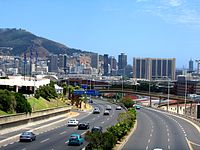
As a legacy of British rule, South Africa drives on the left. This has also influenced neighbouring countries. After South Africa occupied South West Africa (now Namibia) during World War I, it was made a South African mandate by the League of Nations. As a German colony, the territory drove on the right.
South Yemen
South Yemen, formerly the British colony of Aden, changed to driving on the right on 1 January 1977. North Yemen already drove on the right.
Sierra Leone
Sierra Leone changed to right-hand traffic on 1 March 1971.
Singapore
In Singapore, all motorised traffic drives on the left, in vehicles with right-hand drive configuration, a legacy of British colonial rule as a crown colony. Some roads, however due to foreseeable considerations, are designed to prevent traffic flow problems that could result with the standard practice, such as Grange Road between Orchard Road and Somerset Road which is separated by a refuge island, Carver Street by North Bridge Road, parking and compound entrances along the right side of North Bridge Road. In any roads with such a requirement, an entry sign is often displayed at the road divider. Cycling designated lane in parks also practises the keep left rule to correspond with motorway traffic as a safety consideration. As of this, Singapore prohibited new registrations of LHD vehicles.
Pedestrian traffic follows a similar approach as when on a motorway, where pedestrians keep left generally, sometimes with the direction of signs displayed at walkways, stairs and pavements as a form of crowd control.
Spain
Spain drives on the right but the capital city, Madrid, had left-hand traffic in force until 10 April 1924. As a result the Madrid Metro, which dates from 1919, still runs on the left-hand side on all lines.
Sudan
After the Ethiopian change-over from driving on the left to driving on the right in 1964, Sudan had only short borders with only two other countries driving on the left: Kenya and Uganda. In August 1973 Sudan adopted right-hand traffic in accord with most other countries of the Arab world.
Suriname
See Guyana and Suriname.
Suriname and neighboring Guyana are the only two remaining countries in the mainland Americas that drive on the left. The practice for Guyana has been inherited from the United Kingdom. It is not reasonable of why Suriname drives on the left considering that the Netherlands has right-hand traffic but can be explained in a number of reasons. It could be that it was inherited from the British who first colonized the land now known as Suriname in the late 17th century. It could also be that when the Netherlands changed from left to right in the late 19th century Suriname did not.
Sweden
Sweden has right-hand traffic now, but had legal left-hand traffic (vänstertrafik in Swedish) from approximately 1734, when it changed back from a short period of right-hand traffic starting in 1718. With or without legal rule, traditionally the left side was used for carriages. Finland, under Swedish rule until 1809, also drove on the left, and continued to do so as a Russian Grand Duchy until 1858.
This continued well into the 20th century, despite the fact that virtually all the cars on the road in Sweden were LHD. (One argument for this was that it was necessary to keep an eye on the edge of the road, something that was important on the narrow roads in use at the time). Also, Sweden's neighbours Norway and Finland already drove on the right, leading to confusion at border crossings.
In 1955 a referendum was held on the issue, resulting in an 82.9%-to-15.5% vote against a change to driving on the right. Nevertheless, in 1963 the Swedish parliament passed legislation ordering the switch to right-hand traffic. The changeover took place at 5am on Sunday, 3 September 1967, which was known in Swedish as Dagen H (H-Day), the 'H' being for Högertrafik or right traffic.
Since Swedish cars were LHD, experts had suggested that changing to driving on the right would be safer, because drivers would have a better view of the road ahead. The accident rate dropped sharply after the change However, the accident rate soon rose back to near its original level. The speed limits were temporarily lowered.
Trains have left-hand traffic, as a change to right traffic is not considered cost-effective. However, trains in Malmö and further southwest keep to the right, as in neighbouring Denmark; there is a flyover-type crossover north of Malmö.
Taiwan
Taiwan had left-hand traffic under Japanese rule; after world war II the Chinese government changed Taiwan to right-hand traffic in 1946 along with the rest of China.
Thailand
Thailand is one of the few countries outside of Commonwealth of Nations (along with Japan) to drive on the left. It is an unusual case of a LHT country almost totally surrounded by RHT neighbours. LHT in Thailand dates back to its diplomatic relations with Britain since 1826 where the British used Thailand as a shortcut to India. Thailand shares long borders with Burma, Laos, and Cambodia—all of which drive on the right, whereas the border with left-driving Malaysia is a short stretch. Thailand allows both RHD and LHD vehicles on its roads.
Tunisia
Tunisia is a right-hand traffic country. However, there is a 20-metre (66-foot) crossing of the Ave. Habib Bourguiba in Tunis on which left-hand traffic is applied.
Ukraine
Until 1918 parts of Ukraine were part of the Austro-Hungarian which drove on the left. This changed in the 1920s when the territory became part Poland. In Lviv the change-over took place in 1922. The rest of Ukraine always drove on the right.
United Kingdom
The United Kingdom has left-hand traffic. The left-hand drive rule first became compulsory in 1722, to combat increasing traffic congestion on the narrow London Bridge. The Lord Mayor of the City of London ordered that bridge traffic should keep to the left.
As a result of European Union legislation ensuring the free movement of goods, British consumers can buy RHD cars from car dealers in other EU country.
Although the United Kingdom is separated from Continental Europe by the English Channel, the level of cross-Channel traffic is very high; the Channel Tunnel alone carries 3.5 million vehicles per year between the UK and France. Most vehicles crossing the Channel, whether via the Channel Tunnel or on ferries, are UK-registered RHD vehicles. Relatively few drivers from Continental Europe take their LHD cars to the UK, but large numbers of British drivers take their RHD cars to Continental Europe for holidays and even for day trips.
Today, UK motor vehicles including postal delivery vehicles and waste collection vehicles are normally RHD. The main exceptions are service vehicles such as road sweepers and gritters where view of the kerb is more important than of the centre-line. These are generally LHD, although some have controls on both sides.
In cities with heavy tourism, LHD coaches can cause problems as their passengers get off the vehicle into the path of traffic, rather than on a pavement. Some fleet operators who regularly tour from Continental Europe to the UK use coaches with doors on both sides. Conversely, some double-decker buses exported to LHD countries for tourist purposes are converted to have their doors on the other side.
For a variety of reasons, Continental European LHD heavy goods vehicles (HGVs) have become common on the UK's roads, particularly on major routes radiating from ports and the Channel tunnel. An issue arising from this concerns the safety of large LHD vehicles, with blind-spots arising from the LHD and the probable inexperience of drivers with these problems.
In the late 1960s, the Department for Transport studied the question of whether to adopt right-hand traffic. The idea was rejected as unsafe and too costly. Legislation was, however, enacted requiring all road junctions to be designed and built for easy conversion from left- to right-hand traffic. Although conversion has not been pursued, the legislation remains in place.
Exceptions to the rule
There are some locations in the UK where road routing and layout causes traffic to approximate or mimic right-hand traffic patterns and practice. The most notable is Savoy Court outside the Savoy Hotel. Another example is the short links between the two carriageways of Russell Lane in Whetstone. The running-together of two slip roads at Junction 10 of the M4 with the A329(M) near Winnersh, is a particularly distinctive example.
It is also permissible to drive in any lane on a one-way street. The Highway Code usually says 'keep to the left' and this is the norm on motorways and other fast roads, i.e. use the leftmost lane available. But on small roads in towns and cities it is common for one-way streets to split direction at some point, so drivers choose the most appropriate lane, and are encouraged to do so with lane markings, signage, and so on.
During the Lockerbie bombing trial of 2000–02, Camp Zeist in the Netherlands was decreed to be British territory subject to Scots law. However, Dumfries and Galloway Police, who were responsible for policing traffic movements within the compound, effected a clause which required drivers to comply with the Continental European practice of driving on the right.
Traffic drives on the left in the service tunnel of the Channel Tunnel, part of which is in France; however, this is not a public highway.
Military fleets and bases
On some British Army training locations, where the army once trained for conflict in Eastern Europe during the Cold War, traffic is meant to travel on the right. Most military bases in the UK, though, have the normal rule of driving on the left.
Vehicles within United States visiting forces bases in the United Kingdom drive on the left, even though the United States does not provide right-hand drive vehicles for its green fleet. However, its white fleet does have some right-hand drive vehicles for elements such as Non-Appropriated Fund activities and UK-only specialist vehicles. Most white fleet vehicles (known as "GSA" or "TMP" vehicles) are shipped over from the United States and are LHD. This is unlike British practice in Germany, where even UK green fleet vehicles for British Forces Germany have been left-hand drive.
During World War II, American truck makers Ford, Chevrolet, and Dodge built ' Canadian Military Pattern truck' [CMP] for use throughout the British Empire and most were right-hand drive to use in left-traffic countries.
On the Indian Ocean island of Diego Garcia, traffic drives on the right due to the large US military presence there even though it is part of the British Indian Ocean Territory.
United States

All U.S. states and territories except the U.S. Virgin Islands drive on the right. The first keep-right law in the United States, passed in 1792, applied to the Philadelphia and Lancaster Turnpike. New York in 1804 and New Jersey in 1813 also enacted keep-right rules. Only the formerly British thirteen colonies historically drove on the left; the historically French, Spanish, Russian and Hawaiian portions of the United States all drove on the right by the time they were annexed by the United States.
Early American motor vehicles, however, were right-hand drive, following the practice established by horse-drawn buggies. This changed in the early years of the 20th century: Ford changed to LHD production in 1908 with the Model T, and Cadillac in 1916.
Today, U.S. motor vehicles are LHD, except garbage trucks, postal mail, and package delivery vehicles. A large number of vehicles used for rural mail delivery are RHD, thus enabling the driver to access roadside mail receptacles without leaving the vehicle.
American drivers nearly always drive on the right and pass on the left, but state traffic laws generally allow for passing on the right if there is sufficient space to the right of the leading vehicle to pass it safely. Since this is not usually the case, right-side passing is rare except on multi-lane roads and divided highways, or when passing other vehicles that are preparing to turn left.
The U.S. Virgin Islands is the only American jurisdiction that still has left-hand traffic, because the islands drove on the left when the United States purchased the former Danish West Indies from Denmark in 1917. Although Denmark drove and still drives on the right, the Danish West Indies drove on the left because the majority of the European aristocracy living there were British; but there is also a claim the practice of left-side drive was due to the first cars being RHD vehicles imported from Barbados, then still a British colony.
Some limited-access freeways in the U.S. have small sections of road where the directions cross, resulting in traffic that appears to drive on the left. Examples include the Interstate 5 in Southern California during the descent/ascent of the Castaic Grade ( map), several miles of Interstate 85 in Davidson County, North Carolina ( map), Interstate 77 at its interchange with Interstate 85 in Charlotte, North Carolina, a very brief section of Interstate 275 in St. Petersburg, Florida ( map), Interstate 8 east of Yuma, AZ ( map), Arizona State Route 87 in Maricopa County, Arizona through Rincon Pass ( map) and small parts of approaches to Interstate 64 running through Chesapeake, Virginia as part of the Hampton Roads Beltway. Diverging Diamond Interchanges are another example. Because of the limited-access restrictions, the left-hand/right-hand orientation of the oncoming traffic is of no consequence to the driver.
Traffic at Phoenix's Sky Harbour Airport also drives on the left around most of terminal 2 ( map), as does traffic paralleling LeJeune Road in Miami, Florida to the east of Miami International Airport ( map).
Two blocks of Bainbridge Street in Philadelphia, Pennsylvania are divided with traffic driving on the left due to flows from nearby streets and the one-way nature of the street on undivided blocks. However, this street design is effectively a traffic circle. Its status as an exception to right hand traffic is ambiguous because it is a one way street with no section encountering traffic from an opposing lane.
Some parking garages on the left-hand side of one-way streets have left-hand traffic in the driveway, as described above under Croatia.
During Mardi Gras in New Orleans, Louisiana parades drive on the left of Canal Street and against the normal flow of traffic on St. Charles Avenue. In the New Orleans suburb of Metairie, Louisiana all Mardi Gras parades travel down Veterans Memorial Boulevard on the left side of the roadway.
In Seattle, the southbound Highway 99 exit for Battery street exits onto the left side of the roadway, with Battery street becoming one way on the right side going NE. While it's ill-traditional in that Battery street runs up a hill, not side by side with the highway off-ramp, a rare "keep left" sign is used to keep citizens from driving the wrong way ( map).
Uruguay
Uruguay adopted left hand traffic in 1918, but as in many other countries in South America, this was changed to right hand traffic on September 2, 1945. A speed limit of 30 km/h (19 mph) was observed until September 30 in order to avoid major collisions and help ease the public to the change.
Venezuela
In all of Venezuela, traffic drives on the right. However, there are exceptions within the heavily congested capital, Caracas. In the neighbourhood of Las Mercedes, Calle Caroní is LHT for one block due to oncoming traffic turning into it from the one-way Av. Río de Janeiro. In Los Chaguaramos neighbourhood, Av. Las Ciencias is a LHT street because it connects two one-way streets, Calle Humboldt and Av. Neverí. Within the campus of Universidad Simón Bolívar, which is surrounded by a one-way street, there is a street aptly named Calle Inglesa (English Street in Spanish) because left-hand traffic allows a better flow of traffic 10.410312°N 66.879630°W.
Vietnam
Vietnam adopted to right hand traffic when the country was under French rule, and continued after the country was partitioned into North Vietnam and South Vietnam.
Trains

Trains which use segregated track are not usually bound by the same rules as for road traffic in their respective countries, although trams and rail systems which include street running usually are.
General
In France, for instance, cars keep to the right, but the first train lines were built by British engineers, so kept to the left. The Paris RER trains keep left, but the Paris Metro was designed to run on the right. Another anomaly occurs in the Alsace- Moselle region, where trains keep to the right because the lines were built in the late 19th century when Alsace-Moselle was part of Germany. Bridges at the former border allow the trains to swap sides. High-speed TGV trains, however, operate on dedicated lines which were built more recently, but they keep left because they interface with older lines. Madrid Metro trains, as well as Rome Metro (but not Milan) and as Buenos Aires Metro also operate to the left.
Through specific stations of the London Underground's Victoria, Northern and Central Lines, trains run on the right. On the Victoria Line it makes passenger interchange easier at Euston and Kings Cross stations. This does not confuse drivers, since the two lines are in separate tunnels. However, White City on the Central Line is above ground.
In the United States, the former Chicago & North Western railroad ran on the left because when the C&NW built their depots, they were on the left hand side when headed into Chicago. Later a second track was built outside the first one, but because commuters headed into Chicago made more use of a depot building than on their return journey, the railroad ran its trains on the left. However, when it was bought by the Union Pacific in 1995, some of these lines were switched. In the case of the North Line tracks between downtown Chicago and Kenosha, trains still operate left-handed.
There are two notable exceptions in the United States. On the New York City Subway, The B Division's Seventh Avenue station's lower level has trains operating to the left, while the upper level platform normally has trains operating to the right. Commuter trains servicing Boston normally run on the right, but regularly switch to the left, especially when servicing outer stations, such as Haverhill. Because of this, and the unpredictable nature of these change-overs, there are pedestrian crossovers in these stations.
Exceptions to the general rule of left- or right-hand traffic are much more common for trains than for cars. Initially most steam engines were RHD, with the engineer sitting on the right and the fireman on the left. This was customary in the UK and it spread to the USA and elsewhere in the world. RHD was never converted to LHD even if the trains switched to right-hand running. RHD remains the customary way for operating trains, with the driver on the right and the assistant on the left. Some railways, particularly the London Underground, switched to LHD with left-hand running. Left Hand Drive with left hand running also became common on UK mainline railways, with the Great Western Railway being the only one of the "big four" to keep the driver on the right. To ease visibility, GWR signals were also occasionally placed on the right-hand side of the tracks, even though this meant that they were between the running lines, and a few examples of this have managed to survive. Nowadays all British trains (except a few preserved locomotives and a number of narrow-gauge railways) have the driver on the left side of the train, and the signals are also on the left-hand side of the track.
There is potential safety benefit for the train driver to sit on the nearside, farthest away from a collision with whatever might protrude from an oncoming train on the opposite track, such as an open cargo door. The driver's placement on the nearside can facilitate his or her view rearward of station platforms either directly or using mirrors, and of signs and signals usually placed on the outside of double tracks—on the right for right-hand traffic and on the left for left-hand traffic. If 'train orders' or 'tokens' (permission to continue) need to be handed up to the driver while the locomotive is in motion, he or she is best able to receive them from the nearside.
Unlike the road, it is possible for trains safely to run on the "wrong" side if bi-directional signalling is in place. Running on the "wrong" side however is an exception as junctions and other infrastructure are usually optimised for running on the "right" side.
Generally, the left/right principle in a country is followed mostly on double track. On single track, when trains meet, the train that shall not stop often uses the straight path in the turnout, which can be left or right. If the meeting place contains a passenger station, the station sometimes has designated directional tracks and plateaus, for passenger predictability.
Light rail
Light rail vehicles, which usually have at least some operation in city streets, generally have the hand of operation and drive identical to that used on buses and cars in the relevant country, e.g. "driving" on the right side (and thus using left-hand drive) in North America. This is so the trolley/tram operator can pick up and discharge passengers (and, historically, collect their fares, except on proof-of-payment systems) on the same side of the roadway as the buses.
Multiple track usage by country
This section lists by country the tracks on which trains normally travel when there are two or more. Trams and other light rail systems which include some street running are excluded.
In the following countries trains generally keep to left:
- Argentina
- Austria (being converted to right-hand running)
- Australia (In Victoria some lines have been set up for bi-directional running, so it is possible for trains to use right hand track instead of the standard left hand track. Locomotives are still driven on the right.)
- Bangladesh
- Belgium
- Brazil
- Burma
- China
- Chile
- Ecuador
- Egypt
- France (except trains in Alsace and the Moselle part of the Lorraine region and 10 km near Spanish border on LGV Perpignan–Figueres; also except for metro systems other than the one in Lyon)
- Hong Kong (except MTR Ma On Shan Line)
- India
- Ireland
- Israel (except Jerusalem Light Rail)
- Italy (except Milan Metro)
- Japan
- Laos
- Luxembourg
- Malaysia
- New Zealand
- North Korea
- Pakistan (except west area)
- Peru
- Portugal
- Singapore
- Slovenia (the Zidani Most– Dobova line and Hungary border area keeps to the right)
- South Africa
- South Korea (except rapid transit lines that do not interoperate with Korail systems other than line Seoul Subway line 3)
- Spain (approximately 20% of the network drives on the left. - This includes Madrid and Bilbao Metros and routes between Madrid and the north of Spain, originally operated by the Compañía de Caminos de Hierro del Norte.)
- Sri Lanka
- Sweden (except Malmö and further south)
- Switzerland
- Taiwan (TRA- Taiwan Railway Administration)
- Thailand
- UK
- Venezuela
- Vietnam
- Zimbabwe (mostly single track)
In the following countries trains generally keep to the right:
- Afghanistan
- Armenia
- Azerbaijan
- Belarus
- Bulgaria
- Canada
- Croatia
- Czech Republic (except Břeclav–Bohumín line)
- Denmark
- Estonia
- Finland
- Georgia
- Germany
- Greece
- Hungary
- Indonesia
- Iran
- Kazakhstan
- Latvia
- Lithuania
- Mexico
- Mongolia
- Norway
- Netherlands (except HSL-Zuid south of Rotterdam)
- Philippines
- Poland
- Romania
- Russia
- Slovakia
- Spain (approximately 80% of the network drives on the right. - This percentage is likely to increase as all planned new high speed lines will drive on the right except cross-border sections)
- Serbia
- Taiwan ( Taipei Metro)
- Tajikistan
- Turkmenistan
- UAE
- Ukraine
- Uzbekistan
- USA (except trains operating on the former Chicago & North Western right-of-way)
Vessels and aircraft
Generally, all water traffic keeps to the right, under the International Regulations for Preventing Collisions at Sea. This is historically because, before the use of a rudder, the boat was steered by a steering oar (or steer-board), which was located on the right-hand side, hence the starboard side of the boat. The helmsman used his right hand to operate the steer-board while standing in the middle of the boat and looking ahead. Traditionally, boats would also moor with the left hand side to the quay to prevent damage to the steering oar, and this was referred to as larboard (loading side), later replaced by port to prevent confusion from the similar sounding words. By keeping to the right, boats pass " port-to-port", protecting the steering oar. When modern style rudders fixed to the stern were developed, the helmsman was moved amidships (on the centreline), and when steering wheels replaced tillers this generally remained the same. Many motor yachts and other small craft are RHD, but some boats, typically smaller pleasure craft and wooden speedboats are built LHD, to give a better view of approaching and passing traffic.
However, there are exceptions to RHT when passing through bridges, normally indicated at each archway.
The rule of the road at sea is that powered vessels give way to sailing vessels; but as between two powered vessels, if they are crossing the rule is to give way to the starboard, while if they are head on each must navigate to starboard so as to pass port-to-port. q.v. The upshot is that the vessel attempting to pass on the wrong side must give way.
For aircraft and vessels, the US Federal Aviation Regulations provide for passing on the right, both in the air, and on water.
In aeroplanes with side-by-side seating, the pilot-in-command sits on the left, with the first officer, navigator or front seat passenger on the right. In most cases the controls are duplicated, Larger aircraft tend to have duplicate instruments on the right side as well, and in commercial airliners the first officer is just as likely to fly the aircraft from the right while the captain handles other tasks from the left. Helicopters generally place the pilot on the right, though examples exist with the pilot on the left.
